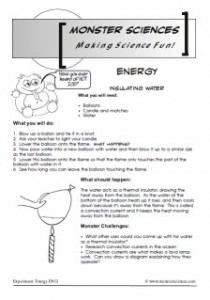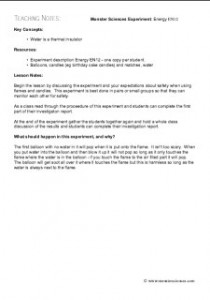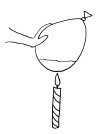Investigate how water can insulate against heat in this fun, and surprising, energy experiment.
 |
 |
An experiment about Energy: Insulating water
What you will need:
• Balloons
• Candle and matches
• Water
What you will do:
1. Blow up a balloon and tie it in a knot.
2. Ask your teacher to light your candle.
3. Lower the balloon onto the flame. What happens?
4. Now pour water into a new balloon with water and then blow it up to a similar size as the last balloon.
5. Lower this balloon onto the flame so that the flame only touches the part of the balloon with water in it.
6. See how long you can leave the balloon touching the flame.
What should happen:
The water acts as a thermal insulator, drawing the heat away from the balloon. As the water at the bottom of the balloon heats up it rises, and then cools down because it’s away from the flame. This is called a convection current and it keeps the heat moving away from the balloon.
Monster Challenges:
• What other uses could you come up with for water as a thermal insulator?
• Research convection currents in the ocean.
• Convection currents are what makes a lava lamp work. Can you draw a diagram explaining how they operate?
TEACHING NOTES: Monster Sciences Experiment: Energy EN1 2
Key Concepts:
• Water is a thermal insulator
Resources:
• Experiment description Energy EN1 2 – one copy per student.
• Balloons, candles (eg birthday cake candles) and matches, water
Lesson Notes:
Begin the lesson by discussing the experiment and your expectations about safety when using flames and candles. This experiment is best done in pairs or small groups so that they can monitor each other for safety.
As a class read through the procedure of this experiment and students can complete the first part of their investigation report.
At the end of the experiment gather the students together again and hold a whole class discussion of the results and students can complete their investigation report.
What should happen in this experiment, and why?
The first balloon with no water in it will pop when it is put onto the flame. I t isn’t too scary. When you put water into the balloon and then blow it up it will not pop so long as it only touches the flame where the water is in the balloon – if you touch the flame to the air filled part it will pop.
The balloon will get soot all over it where it touches the flame but this is harmless so long as the water is always next to the flame.
Get this experiment here or as part of a bundle of 5 Heat Experiments here. There are even more Heat Experiments here!
© www.monstersciences.com



